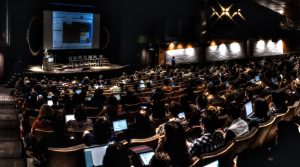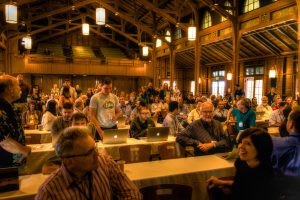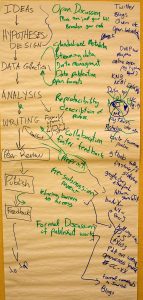23 June 2016
Can a commons design-pattern lexicon show open-science to its destination?
Posted by Lauren Lipuma
This is part of a new series of posts that highlight the importance of Earth and space science data and its contributions to society. Posts in this series showcase data facilities and data scientists; explain how Earth and space science data is collected, managed and used; explore what this data tells us about the planet; and delve into the challenges and issues involved in managing and using data. This series is intended to demystify Earth and space science data, and share how this data shapes our understanding of the world.
By Bruce Caron
The Call for a Scholarly Commons

The April 2016 Future of Research Communications and E-scholarship (Force2016) meeting ended with a call for a scholarly commons.
Credit: Bruce Caron.
After more than a decade of discussion and argument, the international open-science effort is looking for a roadmap to that single destination where it can consolidate its gains and allow science to reboot itself as entirely open. Several groups (e.g., Force11 and the European Commission) are calling for an integrative scholarly commons, where open-science objects—from ideas to published results—can be grown, shared, curated, and mined for new knowledge.
Building a commons is more complex than simply opening up objects to the public. The activity of commoning is what separates a commons from other examples of publicly shared resources. Research into the various commons found across the globe reveals that every successful commons is also an intentional cultural activity. And so, when open-science organizations talk about building a commons, they also need to consider growing a community of commoners.
Lewis Hyde (2010) noted that in Parliament in 1774, Lord Camden said, “If there be any thing in the world common to all mankind, science and learning are in their nature publici juris [belonging to the public by right], and they ought to be as free and general as air or water.”
The agencies and economic forces that have led science and its products away from being “as free and general as air or water” remain with us today. This economy is being disrupted only now by the availability of the internet and the zero marginal-cost of distribution for digital objects.
Open and Optimized
Sci-Hub demonstrates one future for digital science objects: enormous public repositories offering instant, zero-cost access across the planet. For many scientists in a variety of circumstances, Sci-Hub opens access to existing content that was formerly out of their reach. But the Sci-Hub model cannot support the costs of publishing of new content. Science needs a sustainable economic model.
Commoning describes a different future where open repositories of science objects (ideas, methods, data, software, workflows, models, and results) are stewarded by active communities of commoners. Real costs are internalized and also shared, as are tools and other assets, including patents. The goal is to optimize the use of these shared resources within an economy of use that contributes to their long-term maintenance. Science becomes more general, generous, and generative.
While one or more new omnibus science commons will be launched to support open science, the activity of commoning needs to find its home wherever scientists work. As a mode of doing open science, commoning can be practiced in any of the existing science organizations. The idea is not for the commons to be some sort of odd alternative mode of science but rather for this to replace how science is done today. Universities, learned societies, professional associations, and government labs will all be challenged to open up their research objects and foster commoning.
Science Commons Notion: New or Old?
In many ways the commons is how science has long been meant to be done. Robert K. Merton (1973 [1942]) wrote in The Sociology of Science that “four sets of institutional imperatives—universalism, communism, disinterestedness, organized skepticism—are taken to comprise the ethos of modern science.” These imperatives (note: communism here means shared ownership) or similar principles can be reflexively built into the scholarly commons. Commoning will then become an intentional cultural mode for doing science, and will carry the cultural work of science within society. Commoning simply embeds the doing of science back into a reflexive community of scientists who retake control of their own culture and its objects.
Design Patterns for Scholarly Commoning: Solution Spaces and Communication Tools

The Federation of Earth Science Information Partners (ESIP) has been building an active community of commoners for nearly two decades. Here they welcome newcomers at their 2015 Summer Meeting.
Credit: Bruce Caron.
How do we attain an intentional and reflexive cultural purview of commoning for science? One promising idea is to borrow from the open-access software community’s reliance on design patterns. Software design patterns reveal solution spaces and offer a shared vocabulary for software design.
A lexicon of design patterns could play the same role for the scholarly commons (See also: Patterns of Commoning). Since every commons requires a different set of practices suited to its peculiar circumstances, various commons within the academy will need to grow their own ways of commoning. The pattern lexicon would be expanded and improved as these scholarly commons emerge and grow.
Developing a pattern lexicon for the scholarly commons is an important and timely step in the move to an open-science future. Design patterns for a scholarly commons can reveal some promising solution spaces for this challenge, helping the academy make a transition from archaic print- and market-based models to commons models based on open network platforms.
Acknowledgements: Thanks to David Bollier for his contributions to this post.
—Bruce Caron is the executive director of the New Media Research Institute in Santa Barbara, CA.



 GeoSpace is a blog on Earth and space science, managed by AGU’s Public Information staff. The blog features posts by AGU writers and guest contributors on all sorts of relevant science topics, but with a focus on new research and geo and space sciences-related stories that are currently in the news.
GeoSpace is a blog on Earth and space science, managed by AGU’s Public Information staff. The blog features posts by AGU writers and guest contributors on all sorts of relevant science topics, but with a focus on new research and geo and space sciences-related stories that are currently in the news.